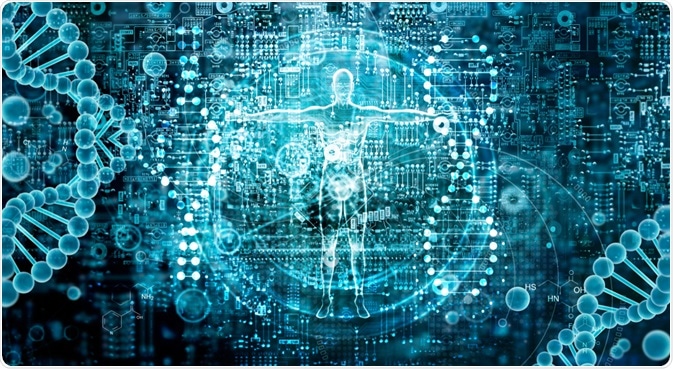Evolutionary developmental biology is also known as “evo-devo”. As the name suggests, this branch of biology deals with the understanding of how changes in the mechanism of embryonic development have an impact on all stages of the life cycle. Evo-devo has successfully elucidated important principles regarding morphological evolution and over the past two decades, molecular genetics has revolutionized evo-devo.

Image Credit: PopTika/Shutterstock.com
Integrated studies including paleobiology, molecular genetics, developmental biology, paleontology, and phylogenetics provide evidence on how features change during evolution. Many scientists have studied evo-devo by focusing on the particular features of organisms and how they evolved. Put simply, they studied the special features that determine the evolution of a particular organism.
One of the examples is the study of feathers to elucidate the origin of birds/flight. Other examples include flowers and the origin of land plants, wings and the origin of insects, and shells and the origin of turtles. These features have provided the theoretical basis of evo-devo studies.
What is the importance of evo-devo studies?
The reason why evo-devo is important in science is that it explains the origin and evolution of environmental developments. These studies explain the role of modifications in the developmental process that resulted in the production of new features. Additionally, how developing organisms interact with their ecological environment to expedite evolutionary modifications is also associated with evo-devo. Another interesting aspect is the understanding of how species maintain their phenotypic variations.
Origins of evo-devo
Scientists have traced back the origin of evo-devo to the late nineteenth century, largely in the Trinity College, Cambridge and in Continental Europe. Evolutionary embryologists became attracted to this field of science following the publication of Charles Darwin’s The Origin of Species in 1859 and Ernst Haeckel’s theory that ontogeny recapitulates phylogeny in 1866.
In the study of crustacean life histories and while testing Darwin’s theory using embryos and larvae, Fritz Müller revealed that ontogeny could be used to study the pattern of evolutionary history (phylogeny) in 1864. This experiment also revealed that evolutionary mechanisms could be pursued in ontogeny. Interestingly, Haeckel stated exactly the opposite theory, i.e., phylogeny explains ontogeny, and established his Biogenetic Law on this basis.
Evo-devo and embryology
Although much information is obtained by studying fossils, it does not provide a complete picture of evolution. There has always been missing data in the study of fossils and, on the other hand, embryos have provided researchers with a way to study evolution in greater detail. Embryos reveal the developmental history of their ancestors. Embryonic development is hierarchical. With time, new properties and mechanisms emerge, which depend on the stages or processes preceding them.
In the study of evolutionary embryology, scientists face various problems that include gaps in the knowledge regarding the development of secondary specialization structures, e.g., the placenta. In 1977, Stephen J. Gould’s book Ontogeny and Phylogeny provided much insight on evo-devo. This book described the term “heterochrony”, which means changes in the timing of developmental processes between a descendant and its ancestors. Recently, evolutionists have provided another explanation of the word “heterochrony” as “evolutionary developmental mechanism”.
Evo-devo and genetics
In 1937 Theodosius Dobzhansky, Ukrainian-American geneticist and evolutionary biologist, published “Genetics and the Origin of Species,” and paved a new way for understanding evolution on the basis of mathematical models, built on principles of population genetics.
Scientists discovered that animals share genes that contain a 180-bp sequence; these genes are known as homeobox, homeotic, or Hox genes. Such genes are also found in plants and fungi.
The discovery of homeobox, homeotic, or Hox genes has proved to be monumental in evo-devo studies. Similarly, the discovery of “master genes”, which are also known as regulatory or developmental genes, has helped scientists to study evolution in greater detail.
For instance, the paired-box protein gene called Pax-6 is found in vertebrates and as eyeless (ey) in Drosophila. Functional studies revealed that Pax-6 is a conserved sequence that is found throughout the animal kingdom, associated with the formation of anterior sensory structures, and controls eye development. Pax-6 gene has been found to be activated in organisms that lack eyes, indicating its ancient developmental role.
Epigenetics has had a tremendous impact on evo-devo. Epigenetics can be defined as the summation of the genetic and non-genetic factors that influence cells to selectively regulate the expressions of genes, and it results in the production of complex phenotypic characteristics.
Future implications
Research based on evo-devo is both comparative and experimental. Studies associated with heterochrony, homeotic genes, and master genes have helped understand the relationships between organisms (phylogenetic trees).
As all organisms evolve with passing time, evo-devo continues to provide information about changes in the development that is related to the evolution of a species.
There have been some modifications in the evo-devo studies which are indicative through their prefixes or suffixes, e.g., eco-evo-devo (ecology with evo-devo), behav-evo-devo (explains the origins of behaviors, learning, and language), evo-devo–niche (evolutionary role of organisms in constructing their niche e.g., nests or tunnels), and evo-devo–medicine (evo-devo in medical practice). More research is required to progress this trend and further this field.
More conceptual unification is required concerning evo-devo. Scientists stated that incorporation of developmental mechanisms, molecular genetics, paleontology, the nature of heredity, and the role of ecology and the environment must be the basis of evolutionary explanations and conceptual unification.
Sources:
- Toth, L.A. (2019) Development, Evolution and Behavior. Encyclopedia of Animal Behavior (Second Edition). Academic Press. pp. 26-32. https://doi.org/10.1016/B978-0-12-809633-8.90040-2.
- Hinman, V.F. (2016). Gene Networks Driving Development, Conservation and Evolution of. Editor(s): Richard M. Kliman. Encyclopedia of Evolutionary Biology. Academic Press. pp. 110-116. https://doi.org/10.1016/B978-0-12-800049-6.00130-X.
- Alessandro, M. (2015) Grand challenges in evolutionary developmental biology. Frontiers in Ecology and Evolution. 2. pp-85. DOI=10.3389/fevo.2014.00085.
- Hall, B.K. (2012) Evolutionary Developmental Biology (Evo-Devo): Past, Present, and Future. Evolution: Education and Outreach. 5, pp. 184–193. https://doi.org/10.1007/s12052-012-0418-x
Further Reading
Last Updated: Dec 14, 2021